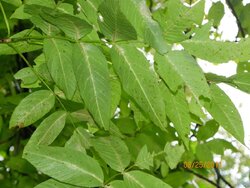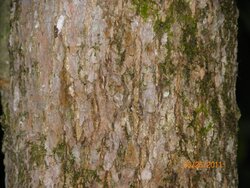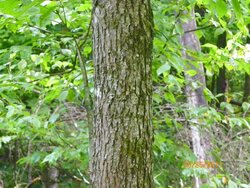Tree Identification
- Thread starter thewoodlands
- Start date
-
Active since 1995, Hearth.com is THE place on the internet for free information and advice about wood stoves, pellet stoves and other energy saving equipment.
We strive to provide opinions, articles, discussions and history related to Hearth Products and in a more general sense, energy issues.
We promote the EFFICIENT, RESPONSIBLE, CLEAN and SAFE use of all fuels, whether renewable or fossil.
You are using an out of date browser. It may not display this or other websites correctly.
You should upgrade or use an alternative browser.
You should upgrade or use an alternative browser.
- Status
- Not open for further replies.
Elim
Member
Backwoods Savage
Minister of Fire
wood-fan-atic
Minister of Fire
Backwoods Savage
Minister of Fire
Wood Duck
Minister of Fire
Zap, Opposite compound leaves means that is an ash. I can't tell which species. I wouldn't guess ash based on the bark, but unless I am wrong about those leaves being opposite, it is an ash.
Wood Duck said:Zap, Opposite compound leaves means that is an ash. I can't tell which species. I wouldn't guess ash based on the bark, but unless I am wrong about those leaves being opposite, it is an ash.
The ash we have from what I've seen is white.
zap
Todd
Minister of Fire
Wood Duck
Minister of Fire
The bark looks a lot like Hop hornbeam (Ironwood), but the leaves definitely aren't Hop Hornbeam. At first I wondered if the leaves are from the same tree as the bark.
Wood Duck said:The bark looks a lot like Hop hornbeam (Ironwood), but the leaves definitely aren't Hop Hornbeam. At first I wondered if the leaves are from the same tree as the bark.
I thought cherry first but the bark looks different.
zap
Zimm
Member
Leaf looks compound which would eliminate cherry or hophornbeam. Shoot color looks green which would say Ash, but could be a English Walnut or perhaps butternut. Z
will711
Minister of Fire
I'm leaning towards Black Ash based on the bark from the photo as it appears to be scaly and flaky rather than furrows and ridges of white ash. Is it growing in a wet area ? That's where they grow in the wild.Wood Duck said:Zap, Opposite compound leaves means that is an ash. I can't tell which species. I wouldn't guess ash based on the bark, but unless I am wrong about those leaves being opposite, it is an ash.
smokinj
Minister of Fire
will711 said:I'm leaning towards Black Ash based on the bark from the photo as it appears to be scaly and flaky rather than furrows and ridges of white ash. Is it growing in a wet area ? That's where they grow in the wild.Wood Duck said:Zap, Opposite compound leaves means that is an ash. I can't tell which species. I wouldn't guess ash based on the bark, but unless I am wrong about those leaves being opposite, it is an ash.
We have a small swamp in that area, this spring and summer it's been full. (Low area that collects all the run off.)
zap
will711
Minister of Fire
I think that seals the deal that's exactly where they like to grow.zapny said:will711 said:I'm leaning towards Black Ash based on the bark from the photo as it appears to be scaly and flaky rather than furrows and ridges of white ash. Is it growing in a wet area ? That's where they grow in the wild.Wood Duck said:Zap, Opposite compound leaves means that is an ash. I can't tell which species. I wouldn't guess ash based on the bark, but unless I am wrong about those leaves being opposite, it is an ash.
We have a small swamp in that area, this spring and summer it's been full. (Low area that collects all the run off.)
zap
nrford
Minister of Fire
Wood Duck
Minister of Fire
It looks like the leaflets are not stalked (they grow from the main stem of the leaf without a stalk), which is one more indication for Black Ash.
Woody Stover
Minister of Fire
Field Guide sez the scaly plates of Black Ash bark "rub off easily" and "takes its name from the dark brown heartwood." Zap?
- Status
- Not open for further replies.
Similar threads
- Replies
- 12
- Views
- 752






